What would your future-you have to say to you?
The no-pants guide to spending, saving, and thriving in the real world.
What would your future-you have to say to you?
I’ve been skipping the Sunday roundups for the last month. Over the last 4 weekends, I have put 2000 miles on my car, taking 4 trips–only one of which I consider optional and that was the only fun trip. With the extra gas, and having to pay for my son’s vision therapy, we went over budget by more than $4,000.
Ouch.
It’s the first debt I’ve picked up in more than 2 years. It’s leaving me twitchy and crabby. I don’t like it much at all.
And, with all of the traveling, I have let the Sunday posts slip.
I am on the Slow Carb Diet. At the end of the month, I’ll see what the results were and decide if it’s worth continuing. For those who don’t know, the Slow Carb Diet involves cutting out potatoes, rice, flour, sugar, and dairy in all their forms. My meals consist of 40% proteins, 30% vegetables, and 30% legumes(beans or lentils). There is no calorie counting, just some specific rules, accompanied by a timed supplement regimen and some timed exercises to manipulate my metabolism. The supplements are NOT effedrin-based diet pills, or, in fact, uppers of any kind. There is also a weekly cheat day, to cut the impulse to cheat and to avoid letting my body go into famine mode.
I’m measuring two metrics, my weight and the total inches of my waist , hips, biceps, and thighs. Between the two, I should have an accurate assessment of my progress.
Weight: I have lost 45 pounds since January 2nd. I haven’t weighed in since my last Sunday update. For the last week, I haven’t been terribly strict about being on the diet and I haven’t stressed about staying on it while traveling.
Total Inches: I have lost 27 inches in the same time frame.
Every home needs a secret tunnel. Every time a house in my neighborhood goes up for sale, I try to convince my wife we should buy it and connect it to ours with tunnels.
Some day, when I’m a brazillionaire, if I hate my descendants, I’m going to set up my will to frustrate them all.
Haggling is a skill I need to work on.
The Monster Hunter Alpha early advanced reader copy is available. The Monster Hunter books are fun, fast reads.
Bacon art makes me cultured and hungry.
Making strangers smile is a way to make your day memorable.
I always get a warm fuzzy feeling when I hear about people successfully chasing their dreams.
I need to find a use for some of the unique materials here.
Karate Guess So was the winner of last week’s Best of Money Carnival! Woo!
Debt Options was included in the Festival of Frugality.
Budgeting Sucks was included in the Carnival of Personal Finance.
The Benefits of Ignorance was included in the Totally Money Blog Carnival.
New Debt was included in the Yakezie Carnival.
Thank you! If I missed anyone, please let me know.
There are so many ways you can read and interact with this site.
You can subscribe by RSS and get the posts in your favorite news reader. I prefer Google Reader.
You can subscribe by email and get, not only the posts delivered to your inbox, but occasional giveaways and tidbits not available elsewhere.
You can ‘Like’ LRN on Facebook. Facebook gets more use than Google. It can’t hurt to see what you want where you want.
You can follow LRN on Twitter. This comes with some nearly-instant interaction.
You can send me an email, telling me what you liked, what you didn’t like, or what you’d like to see more(or less) of. I promise to reply to any email that isn’t purely spam.
Have a great week!
Today, I am continuing the series, Money Problems: 30 Days to Perfect Finances. The series will consist of 30 things you can do in one setting to perfect your finances. It’s not a system to magically make your debt disappear. Instead, it is a path to understanding where you are, where you want to be, and–most importantly–how to bridge the gap.
I’m not running the series in 30 consecutive days. That’s not my schedule. Also, I think that talking about the same thing for 30 days straight will bore both of us. Instead, it will run roughly once a week. To make sure you don’t miss a post, please take a moment to subscribe, either by email or rss.
On this, Day 11, we’re going to talk about one method of paying for college.
I have a secret to share. Are you listening? Lean in close: College is expensive.
You’re shocked, I can tell.
The fact is, college prices are rising entirely out of proportion to operation costs, salaries, or inflation. The only thing college prices seem to be pegged to is demand. Demand has gotten thoroughly out of whack. The government forces down the interest rates on student loans, then adds some ridiculous forgiveness as long as you make payments for some arbitrary number of years, creating an artificial demand that wouldn’t be there if the iron fist of government weren’t forcing it into place.
Somebody in Washington has decided that the American dream consists of home ownership and a college education. Everything is a failure. He’s an idiot.
College isn’t for everybody.
Read that again. Not everyone should go to college. Not everyone can thrive in college.
Fewer than half of students who start college graduate. The greater-than-half who drop out still have to repay their loans. Do you think college was a good choice for them?
Then you get the people who major in art history and minor in philosophy. Do you know what that degree qualifies you for? Burger flipping.
Yes, I know. Just having a degree qualifies you for a number of jobs. It’s not because the degree matters, it’s because HR departments set a series of fairly arbitrary requirements just to filter a 6 foot stack of resumes. The only thing they care about is that having a degree proves that you were able to stick college out for 4 years. That HR requirement matters less as time goes on and you develop relevant work experience.
A liberal arts education also—properly done—trains your mind in the skill of learning. First, not everyone is capable of learning new things. Second, not everyone is willing to learn new things. Third, a passion for learning can be fed without college. If you don’t have that passion, college won’t create it. Most of the most learned people throughout history managed without college, or even formal education. Even if you want to feed that passion in a formal classroom, you’re assuming the professors are interested in training your mind instead of indoctrinating it with their views.
Now there are some pursuits that outright require a college education. The sciences like engineering, physics, astronomy, and psychiatry all require college. You know what doesn’t require college? Managing a cube farm. Data entry. Sales. I’m not saying those are bad professions, but they can certainly be done without dropping $50,000 on college.
Some careers require an education, but don’t require a 4 year degree, like nursing(in most states), computer programming(it’s not required, but it makes it a lot easier to break into) and others. Do you need to hit a 4 year school and get a Bachelor’s degree, or can you hold yourself to a 2 year program at a technical college and save yourself 40,000 or more?
That should be an easy choice. Don’t go to college just because you think you should or because somebody said you should, or to get really drunk. College isn’t for everybody and it’s possible it’s not for you.
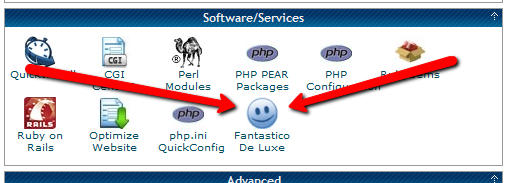
In this installment of the Make Extra Money series, I’m going to show you how to set up a WordPress site. I’m going to show you exactly what settings, plugins, and themes I use. I’m not going to get into writing posts today. That will be next time.
I use WordPress because it makes it easy to develop good-looking sites quickly. You don’t have to know html or any programming. I will be walking through the exact process using Hostgator, but most hosting plans use CPanel, so the instructions will be close. If not, just follow WordPress’s 5 minute installation guide.
Assuming you can follow along with me, log in to your hosting account and find the section of your control panel labeled “Software/Service”. Click “Fantastico De Luxe”.

On the Fantastico screen, click WordPress, then “New Installation”.
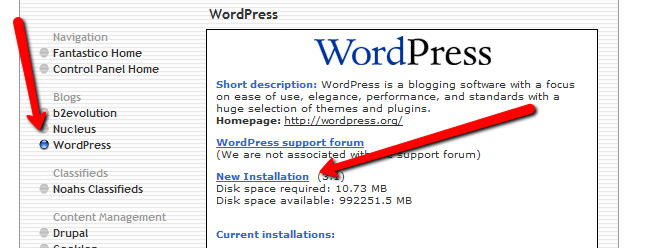
On the next screen, select your domain name, then enter all of the details: admin username, password, site name, and site description. If you’ll remember, I bought the domain http://www.masterweddingplanning.net. I chose the site name of “Master Wedding Planning” and a description of “Everything You Need to Know to Plan Your Wedding”.
Click “install”, then “finish installation”. The final screen will contain a link to the admin page, in this case, masterweddingplanning.net/wp-admin. Go there and log in.
After you log in, if there is a message at the top of the screen telling you to update, do so. Keeping your site updated is the best way to avoid getting hacked. Click “Please update now” then “Update automatically”. Don’t worry about backing up, yet. We haven’t done anything worth saving.
Next, click “Settings” on the left. Under General Settings, put the www in the WordPress and site URLs. Click save, then log back in.
Click Posts, then Categories. Under “Add New Category”, create one called “Misc” and click save.
Click Appearance. This brings you to the themes page. Click “Install Themes” and search for one you like. I normally use Headway, but before I bought that, I used SimpleX almost exclusively. Your goal is to have a simple theme that’s easy to maintain and easy to read. Bells and whistles are a distraction.
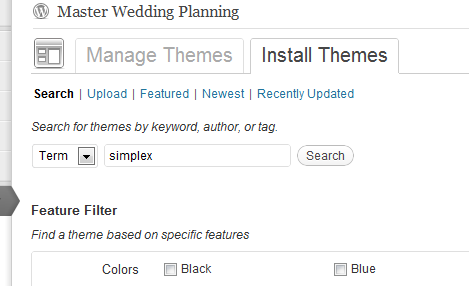
Click “Install”, “Install now”, and “Activate”. You now have a very basic WordPress site.
A plugin is an independent piece of software to make independent bits of WordPress magic happen. To install the perfect set of plugins, click Plugins on the left. Delete “Hello Dolly”, then click “Add new”.
In the search box, enter “plugin central” and click “Search plugins”. Plugin Central should be the first plugin in the list, so click “install”, then “ok”, then “activate plugin”. Congratulations, you’ve just installed your first plugin.
Now, on the left, you’ll see “Plugin Central” under Plugins. Click it. In the Easy Plugin Installation box, copy and paste the following:
All in One SEO Pack Contact Form 7 WordPress Database Backup SEO SearchTerms Tagging 2 WP Super Cache Conditional CAPTCHA for WordPress date exclusion seo WP Policies Pretty Link Lite google xml sitemaps Jetpack by WordPress.com
Click “install”.
On the left, click “Installed Plugins”. On the next screen, click the box next to “Plugins”, then select “Activate” from the dropdown and click apply.
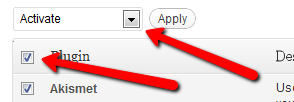
Still under Plugins, click “Akismet Configuration”. Enter your API key and hit “update options”. You probably don’t have one, so click “get your key”.
The only tool I worry about is the backup. It’s super-easy to set up. Click “Tools”, then “Backup”. 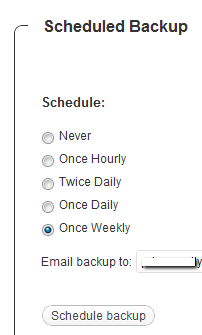
Scroll down to “Schedule Backups”, select weekly, make sure it’s set to a good email address and click “Schedule Backup”. I only save weekly because we won’t be adding daily content. Weekly is safe enough, without filling up your email inbox.
There are a lot of settings we’re going to set. This is going to make the site more usable and help the search engines find your site. We’re going to go right down the list. If you see a section that I don’t mention, it’s because the defaults are good enough.
Set the Default Post Category to “Misc”.
Visit this page and copy the entire list into “Update Service” box. This will make the site ping a few dozen services every time you publish a post. It’s a fast way to get each post indexed by Google.
Click “Save Changes”.
Uncheck everything under “Email me whenever…” and hit save. This lets people submit comments, without actually posting the comments or emailing me when they do so. Every once in a while, I go manually approve the comments, but I don’t make it a priority.
Select “Custom structure” and enter this: /%postname%/
Click save.
Set the status to “Enabled”, then fill out the site title and description. Keep the description to about 160 characters. This is what builds the blurb that shows up by the link when you site shows up in Google’s results.
Check the boxes for “Use categories for META keywords” and “Use noindex for tag archives”.
Click “Update Options”.
Check the boxes to remove each of the dates and set the alt text to “purpose” or something. This will suppress the date so your posts won’t look obsolete.
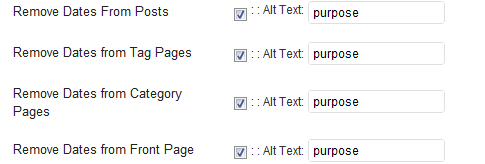
This plugin reinforces the searches that bring people to your site. It’s kind of neat. Skip the registration, accept the defaults and hit save.
Scroll to the bottom and click import. We’ll come back to this.
Select “Caching On” and hit save.
Across the top of the screen should be a giant banner telling you to connect to WordPress.com and set up Jetpack. You’ll need an account on WordPress.com, so go there and set one up. After authorizing the site, you’ll be brought back to the Jetpack configuration screen. Click “Configure” under “WordPress.com Stats”. Take the defaults and hit save.
On the contact configuration page, copy the code in the top section. You’ll need this in a moment.
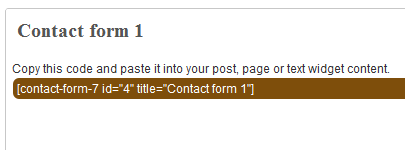
Now, we going to create a couple of static pages. On the left, click “Pages”, then “Add new”.
Name the first page “Contact” and put the contact form code in the body of the page. Hit publish.
Under Appearance, click “Menu”. Enter a menu name and hit save.
Then, under “Pages”, click the box next to “Contact”, “Disclaimer”, and any other policies you’d like to display. Hit save.
Also under Appearance, click “Widgets”. This is where you’ll select what will display in the sidebar. All you have to do is drag the boxes you want from the middle of the page to the widget bar on the right. I recommend Text, Search, Recent Posts, Popular Search Terms and Tag Cloud. In the text box, just put some placeholder text in it, like “Product will go here”. We’ll address this next time.
We’re not going to worry about getting posts in place, yet. That will be the next installment. However, the steps in the next installment could take 2 weeks to implement, and we want Google to start paying attention now. To make that happen, we need to get a little bit of content in place. This won’t be permanent content. It’s only there so Google has something to see when it comes crawling.
To get this temporary, yet legal content, I use eZineArticles. Just go search for something in your niche that doesn’t look too spammy.
Then, click “Posts”, then delete the “Hello World” post. Click “Add new”. Copy the eZine article, being sure to include the author box at the bottom, and hit publish.
To see your changes, you may have to go to Settings, then WP Cache and delete the cache so your site will refresh.
Congratulations! You now have a niche blog with content. It’s not ready to make you any money, yet, but it is ready for Google to start paying attention. In the next installment, I’ll show you how I get real unique content and set it up so Google keeps coming back to show me the love.

I have 16 personal savings accounts, 3 personal checking accounts, 2 business checking accounts, and 2 business savings accounts. That’s 23 traditional bank accounts, spread across 3 banks. Just talking about that gives my wife a headache.
Every account has a reason. Three of the savings accounts exist just to make the matching checking accounts free. One of the checking accounts handles all of my regular spending that isn’t put on my rewards card. 14 of the savings accounts are CapitalOne 360 accounts that have specific goals attached. A couple of the accounts were opened to boost the sales numbers for a friend who is a banker. Really, it’s almost too much to keep track of. One credit card, 5 checking accounts, 18 savings account, all on 4 websites.
Sometimes, when you extend your bank accounts this far, it gets easy to let it all slip away and lose track of where your money is going. How do I keep track of it all?
Whoa, you say? Simplify? I don’t simplify the number of accounts I have, I simplify the tracking, or specifically, the need to track.
Twice a month, I have an automated transfer that moves a chunk of money from my main checking account to C1360. I have a series of transfers set up there that move that money around to each of my savings goals. I move $100 to the vacation account, $75 to the braces account, and $10 to the college fund, among all of the other transfers. Doing that eliminates any need to keep track of the transfers, since it is all automated.
Using the same rules, I make every possible payment happen automatically, so I don’t have to worry about paying the gas bill or sending a check to the insurance company.
Simple.
As you saw in the opening sentence of this post, I also complicate the hell out of my accounts. On the surface, it would seem like that would make it harder to keep track, but in reality, the opposite is true. I have 14 savings accounts at C1360, each for a specific savings goal, like paying my property taxes or going to the to Financial Blogger Conference in October. I can log in to my account and tell at a glance exactly how much money I have for each of my goals. In the account nickname, I include how much each goal is for, so I can easily see if I am on track.
Everything I do gets set up in Quicken. This makes it easy to track how much actual money I have available. Since I’ve moved my daily expenses to a credit card, I only have about a dozen entries to worry about when I balance my checkbook at the end of the month. At that time, any excess funds get dropped into my debt snowball.
This may all leave me with a needlessly complicated system, but it’s a system that grew slowly to meet my needs and it is working well for me. I spend about 2 hours a month tracking my finances, and can–at any time–tell at a glance exactly how my finances look.
How do you keep your finance organized? Have you tried any unique savings strategies?

Having a well-funded emergency fund is one of the foundation blocks for almost every saving or debt-repayment plan. The theory is that you’ll be better able to weather a financial storm if you don’t have to raid your budget or beat on your credit card every time an unexpected expense rears its ugly head. The number varies based on your pundit and your stage of life, but generally ranges from $1000 to 8 months of your expenses. The money needs to go in a liquid account, so it can be accessed when necessary, but it needs to be completely ignored otherwise. What good is an emergency fund that has been spent?
Now that you have your emergency fund, you are set, right? But what happens when something comes up? When is it okay to spend that money? Emergencies can take so many forms: medical emergencies, car repairs, accidents, a good sale. Wait. What was the last one? What actually constitutes an emergency that is worth shredding your security blanket?
Here are three questions to ask yourself before you spend that money:
Your emergency fund should only be used on things that are important, necessary, and urgent. Anything else should get postponed until you can afford to pay it using your on-budget expense items. As the wise man once said: “Lack of planning does not constitute an emergency.” Of course, if you are in a financially stable situation and willing to take a small risk for a short time, eliminating an entire debt item to save the interest can be the right decision.
What would you be willing to spend your emergency fund on?